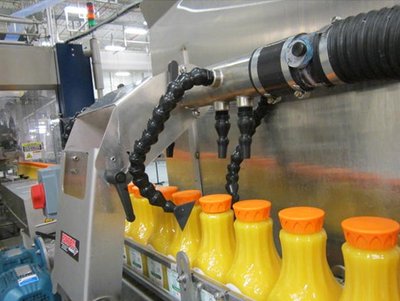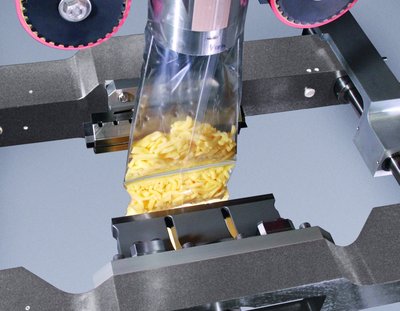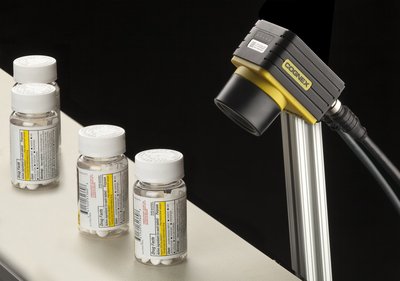Sustainable production and packaging benefits both manufacturers and consumers
A 17,000-person survey covering 17 nations, the 2010 Greendex research study from National Geographic and GlobeScan found 40% of consumers avoid excessively packaged goods “all” or “most of the time”. Another survey, the Natural Marketing Institute’s 2011 LOHAS Consumer Trends Study, found 75% of Americans believe many consumer products are overpackaged.
Along with minimal packaging consumers like recyclable packaging, environmentally friendly packaging materials and to support consumer packaged goods companies (CPGs) that bring sustainability to the production floor with improvements to reduce energy usage or air and water waste.
Following, some of the exhibitors at the upcoming PACK EXPO International in Chicago share some of their environmentally-friendly materials and innovations which can improve productivity while reducing carbon footprints.
Sustainable process improvements
In many instances, changes in the design and layout of a manufacturing facility can make a difference in a company’s sustainability goals.
“Environmentally sensitive design and manufacturing improves efficiency and reduces the costs of processing, inspection and packaging machinery,” says Brian Barr, Packaging Systems Sales Manager, Heat and Control. “Precision laser and water-jet cutting of materials and unitised equipment designs reduce waste, air pollution and the number of parts required to build each machine. Modular machinery cuts the time, labour and floor space required for installation. We now also offer equipment that recovers energy from cooker exhaust and conveyor drives that can be re-used with different pans - not scrapped - when line layouts change.”

QuikWater offers a sustainable direct-contact water system for heating sanitation and process water for the food manufacturing industry. “Our patented clean-burn technology outperforms traditional boiler systems on virtually every level - from improving worker safety to being more energy efficient,” says Tammy Collins, Sales Manager at QuikWater. “Whether you need as little as 20 L of hot water per minute or as much as 8500 L/min up to 93°C, there’s a system that’s right for your application.
“The system is non-pressurised, so no boiler codes are required, and there is no need for special operators or AMSE stamps,” adds Collins. “It is also up to 40% more fuel efficient than typical steam-to-hot-water systems, which means less fuel and less energy are required. This lowers overall operating costs. And with a 20 to 40% reduction in carbon dioxide emissions, the system reduces a company’s carbon footprint.”
Centrifugal blowers and air delivery devices from Paxton Products, an ITW company, provide clean dry air and reduce energy usage during packaging and labelling by as much as 80%, as compared to compressed air systems.

“Each Paxton system is custom engineered for drying based on the size and shape of the target product and the line configuration,” says Barbara Stefl, General Manager at Paxton. “The devices can be configured either to deliver a curtain of air, to dry the top and sides, or with the new Air Halo, to deliver a 360° halo of air to dry top, bottom and sides at once.”
Stäubli Robotics now offers the TP80 fast picker, a new series of high-speed pickers that deliver greater speeds (up to 200 picks per minute) and more flexibility at a lower cost to the packaging market. This robot is more agile and lighter weight, has extremely fast cycle time and maintains high, repeatable precision throughout the entire work envelope. A simple base or wall mounting eliminates the need for a large gantry, further enhancing cost effectiveness and ease of integration.
Hidden green opportunities
Even small changes to packaging machinery can impact a CPG’s sustainability efforts. Tom Miller, Bearings Unit Manager-North America, igus, points out, for example, the benefit of switching from metal bearings to dry-running plastic bushings, which do not require lubrication and require less energy to produce.
“These days, many companies are working hard to reduce their carbon footprint on the environment, but this does not happen overnight,” says Miller. “It is usually a culmination of changes that take place over time, in a number of different areas. Even small changes to the design of a packaging machine can make a difference.
“We offer an FDA-compliant bushing material that is blue in colour for easier detection,” says Miller. “The iglide A350 plastic bushings are highly wear resistant and can handle long-term temperatures up to 180°C. They are suitable for applications in the food, packaging and bottle-filling industries. They deliver low coefficients of friction and are resistant to a variety of chemicals and other liquids.
“They are also extremely lightweight, which helps reduce fuel consumption and carbon dioxide output,” he adds. “And they do not require environmentally harmful galvanising baths to achieve chemical resistance, unlike metals that often have to be coated using an environmentally unfriendly, high-energy zinc galvanising bath to achieve this effect.”
Tom Duffy, National Sales Manager, Badger Plug, says, “The scope of package sustainability should include recycling and the re-use of packaging components as part of the need to reduce waste and save money. Today, manufacturers and converters of film, paper, metals, textiles, etc consume large amounts of packaging that can often be recycled. Roll protection products such as core plugs and suspension packaging need to be part of the sustainable discussion.
“An experienced provider of recycled packaging can help avoid the pitfalls that can occur when dealing with recycled/used packaging,” adds Duffy. “Low-cost packaging components such as single-core plugs are generally difficult to re-use due to freight costs, damage and cleanliness. More expensive suspension components such as end boards, sleeve plugs, pallets and channels/clips are readily recycled. Everyone in the business transaction can find value in this recycling process. Plus, the impact on our environment is greatly reduced.”
Eco-friendly, food-specific package modifications
An increasing number of shoppers are seeking out coffee products produced and harvested in a sustainable manner - including beans grown in a manner that is kind to the environment and its people. Coffee marketers who want to take this to the next level also want sustainable packaging options, such as the Flexis Air valve from Avery Dennison Designed and Engineered Solutions.
“Flexis technology allows for up to a 30% increase in application throughput and a 30 to 50% product purchase advantage over hard valves,” claims Nick Greco, Business Development Manager at Avery Dennison. “Plus, they offer exceptional performance characteristics. Tests conducted by a major university show that the valve maintains less than 2% residual oxygen for 24 months, equalling the reliability of hard button valves.”
The Flexis Air valve employs about 90% less plastic than injection-moulded plastic degassing valves, creating another opportunity to reduce carbon footprints and non-recyclable waste. The valves are also pre-oiled with a precise amount of food-grade silicone oil at the necessary valve location to protect against oxygen ingress. The pre-oiled feature can save time and reduce scrap and clean-up by eliminating the need to oil valves during the packaging process.
Sustainable advancements in can packaging of ground coffee, milk powders such as infant formula and other dry, powdered products include technologies that reduce the use of typical gases required for a modified-atmosphere environment. For example, the INDOSA Can Process Center (CPC) 127-10 ProVac from Grabher INDOSA AG uses proprietary vacuum technology.
“The high efficiency is guaranteed by 10 stationary workstations, which are in use more than 90% of the process time,” says Michael Grabher, Vice President of Grabher INDOSA. “The system includes evacuating, gassing and seaming, and allows the customer to vary the end pressure inside the can. With this technology, it is not necessary to use carbon dioxide, as the underpressure of each can is adjustable and less than 0.5% oxygen content can be achieved.”
He adds that nitrogen consumption is reduced to a minimum, because each can is gassed in a separate stationary chamber only slightly larger than the can - improvements in efficiency and gas use that reduce a canner’s carbon footprint.
For baggers of milk powders or other dried ingredients such as bakery mixes, flour, soy protein, starch, spices, sugar, etc, Premier Tech Chronos has recently developed the BFW Series Open-Mouth Bagger with Bottom-Up Filler, a sustainable solution for the bagging of powdery materials. This innovative system is the combination of a hygienic vertical main feeder (meets 3A standards), FANUC Robot(s) and a bottom-up filling system.
“It is certainly the best hygienic approach in the industry and has a very high accuracy on weight (up to ±15 g),” says Yan Gagné, Engineering Supervisor at Premier Tech Chronos. “It can produce airtight bags for long-term storage and is equipped with a large bag magazine that provides long-production runs, very few modules and a great floor clearance.
“Furthermore, the BFW Series provides both versatility and speed since it can handle paper, polyethylene, laminated polywoven and Cap-Sac (a PE bag within a paper bag) bags at up to 12 bags/min, depending on products, bag sizes and applications,” says Gagné. “Complete control on side-gusseted pinch top bags is achieved; no gusset realignment device is required.”
As the EPA tightens rules and regulations on conventional aerosol hydrocarbon propellants, the bag-on-valve package (BOV) is a growing trend in the aerosol industry. “A rolled up aluminium bag is welded or attached to an aerosol valve,” says Jim McBride, owner of MBC Aerosol. “Compressed air is charged into the can and an aerosol valve with the bag attached is crimped onto the container. The product is forced through the aerosol valve stem to fill the bag. When the spray button is pressed, the product is squeezed out of the bag by the compressed air, which creates the aerosol spray via the spray button orifice.
“The major benefit of this package is the lack of volatile organic compounds,” McBride says. “The other benefit is that it is completely recyclable. Plus, about 99% of the product is squeezed out so the only thing left is aluminium and 30 to 40 psi of compressed air. A variety of foods are making their way into this package, including olive oils and salad dressing.”
Getting green through package processing modifications
Sometimes a modification to a current packaging process can assist with saving money, materials and energy.
Vacuum Barrier now offers Nitrodose Liquid Nitrogen Dosing Systems, which allow manufacturers to use the most lightweight PET and aluminium can packaging by providing the most precise liquid nitrogen dosing at the highest discrete dosing speeds. “This eliminates liquid nitrogen waste and reduces consumption by having a very low LN2 delivery pressure along with both speed and dose compensation,” says Edward Hanlon Jr, Vice President Sales at Vacuum Barrier. “It also allows for a reduction in packaging materials.”
Induction heating is a method of providing fast, constant heat for electrically conductive materials. Although the basic principles of induction are well known, modern advances in technology have made induction heating a remarkably simple, cost-effective heating method. Formost Fuji has adapted this technology to sealing film on its horizontal wrapping machine.
This technology has reduced the cost of maintenance, increased the reliability and stability of the heater system, reduced energy usage and greatly extended the useful life of the parts. In addition, through the reduction of moving parts, the component is much less complicated, which all adds up to a better system.
In a bid to reduce the amount of material used to seal plastic packages, ultrasonic sealing technology, which has been around for more than 50 years, is now being used more frequently in packaging. New and innovative solutions reduce the amount of material being used for packaging and ultrasonic sealing reduces power consumption while improving overall equipment efficiency (OEE). Installed applications include bagged salad, beverage, coffee, dairy, pasta, ready-cooked meals and powdered products.

“For vertical form-fill-seal (VFFS) machines, ultrasonic allows welding through contamination on the cross seal - this results in less headspace for the package and reduced sealing width,” says Uwe Peregi, Executive Vice President and General Manager, Herrmann Ultrasonics. “Thanks to the feedback on the ultrasonic technology, each seal is validated with modern generators, which allows statistical process control monitoring. Further, the molecular weld process starts from the inside layer, which results in reduced sealing time and less abrasion of the film.”
Ensuring label accuracy
Due to miniaturisation and advances in the power of digital signal processors, imaging sensors and decoding algorithms, traceability applications such as ID code reading, text verification, mark quality assessment and label inspection can now be accomplished more economically using the latest generation of smart camera vision systems.
“The most advanced of these smart camera vision systems now offer advanced networking, communication capabilities and powerful factory integration tools,” says John Lewis, Market Development Manager, Cognex. “And with a standard operator interface for a common look and feel across all packaging lines and inspection points, many packagers and materials suppliers now consider smart camera vision systems indispensable in their efforts to build strategic information architecture in line with corporate sustainability goals.”

Such vision systems help reduce defects and eliminate scrap, he adds. “It’s really better for the environment to use machine vision, but it’s also better for the manufacturer because it reduces production costs by increasing manufacturing yields to help them achieve their corporate sustainability goals.”
For example, label, material and container suppliers use a lot of vision systems and image-based barcode readers. Suppliers of pre-printed labels, injection-moulded bottles, flexible films and carton-board containers use vision to eliminate misprints and mix-ups. Packaging materials including onserts and inserts are often furnished pre-printed with barcodes and characters that must be verified. Label-converting companies use vision and image-based barcode readers to ensure code quality and data integrity on their serialised labels. Mistakes on any of these items can result in costly FDA-mandated recalls.
Turning sustainability into an advantage in food and beverage
Nearly half of all Australian shoppers are influenced by sustainability when making purchases,...
The 'flour effect' pathway to Scope 3 emission cuts
An Australian Study reveals how a simple ingredient could become a climate solution for food...
Whey to go up: unlocking further potential for cheese by-product
A new mixed-method study explored four models that could provide potential for the Australian...











